Fermenting your own sauerkraut is a fun and rewarding way to preserve cabbage and create a tangy, probiotic-rich condiment. Fermentation involves allowing beneficial bacteria to break down the sugars in the cabbage, resulting in a tangy and slightly sour flavor.
Making sauerkraut at home is surprisingly easy, requiring simple ingredients and patience. We’ll take you through the steps of how to ferment traditional sauerkraut. From gathering the right ingredients to creating an anaerobic environment for fermentation, we’ve got you covered.
We’ll also explore different methods for making sauerkraut, including slicing, pounding, and kneading cabbage and using whole cabbage heads with brine. Get ready to enjoy the tangy and probiotic-rich goodness of homemade sauerkraut.
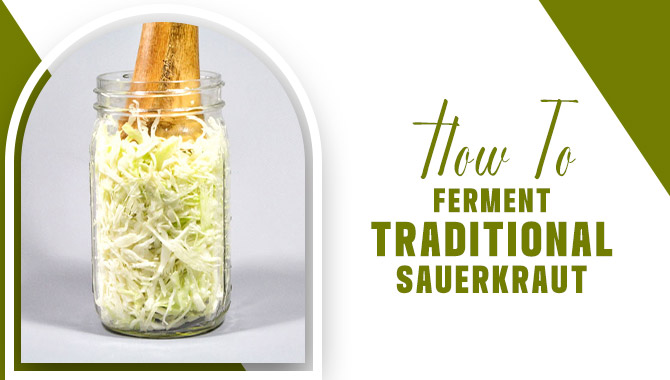
How To Ferment Traditional Sauerkraut: Homemade Sauerkraut Recipe
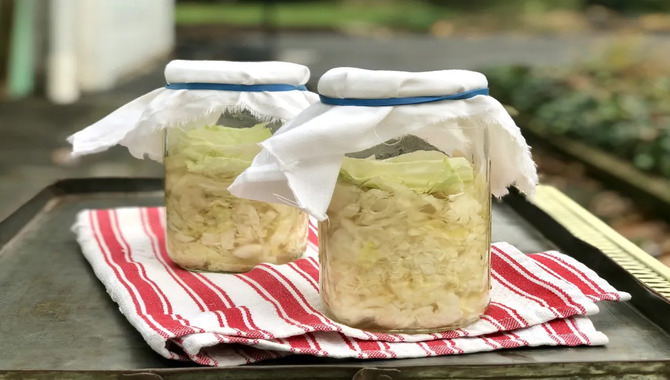
To make your own tangy and probiotic-rich sauerkraut, follow these simple steps for traditional fermentation. Start by preparing the cabbage, ensuring you remove the outer leaves and shred or slice it. Gently massage the cabbage with sea salt, stimulating the release of natural juices.
Don’t forget to add a touch of your favorite spices or flavorings for a personalized touch. Once the cabbage is well-coated, pack it tightly into a fermentation vessel, ensuring it is fully submerged in its own liquid. Cover the vessel with a lid or cloth, allowing gases to escape without allowing contaminants to enter.
However, Making traditional sauerkraut at home is a fun and rewarding process. Here are simple steps on how to ferment traditional sauerkraut recipe homemade:
Ingredients For Homemade Sauerkraut
To create your very own homemade sauerkraut, you’ll need a few key ingredients. Start by selecting fresh, firm cabbage. The cabbage is the show’s star in this fermentation process, so choosing a head free from any blemishes is crucial. The next essential ingredient is non-iodized salt, such as sea or kosher salt.
This type of salt is vital for fermenting as it helps draw out the cabbage’s natural juices while inhibiting the growth of harmful bacteria. For added flavor variations, consider incorporating optional ingredients like carrots, garlic, or spices such as caraway seeds. These additional elements can give your sauerkraut a unique twist and enhance its overall taste.
Use Fresh Cabbage
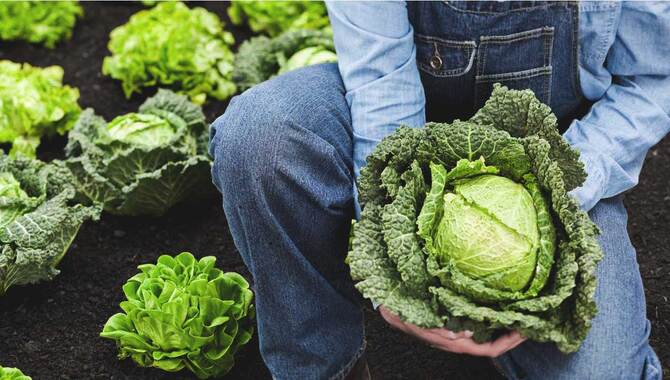
For optimal homemade sauerkraut, begin with fresh cabbage. Prioritize using a crisp and firm head of cabbage, ensuring to remove any wilted or damaged outer leaves. Cut the cabbage into thin strips using a sharp knife or a mandoline slicer, and transfer it to a large mixing bowl.
Lightly sprinkle the cabbage with salt, then massage it thoroughly, applying pressure to release all the natural juices locked within. With the salted cabbage ready, pack it tightly into a clean fermentation vessel, such as a glass jar or ceramic crock, setting the stage for a successful fermentation process.
Use The Right Salt
When fermenting sauerkraut, using the right salt is essential for a successful fermentation process. Opt for non-iodized salt, like sea salt or kosher salt, as iodine can inhibit fermentation. Steer clear of table salt and salt with additives, as they can negatively impact both the fermentation process and the taste of your sauerkraut.
The ideal ratio is 1-2 tablespoons of salt per pound of cabbage. This salt will draw out moisture from the cabbage, creating the perfect environment for the growth of beneficial bacteria, probiotics, and lactic acid bacteria responsible for fermentation.
Create An Anaerobic Environment For Your Sauerkraut
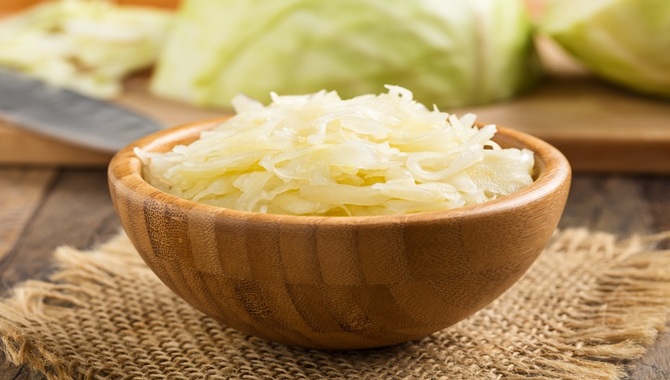
To achieve optimal fermentation for your sauerkraut, it is crucial to create an anaerobic environment. Start by tightly packing the shredded cabbage into a fermentation vessel, such as a glass jar or a ceramic crock, leaving enough space for expansion.
Prepare a brine solution by dissolving salt in water and adjusting the ratio to your desired saltiness. Carefully pour the brine over the cabbage, ensuring it is completely submerged. To prevent any exposure to air, use a fermentation weight or a clean, food-safe rock to keep the cabbage under the brine.
Cover the container with a clean cloth or use a specialized fermentation lid that allows gases to escape. Now, place the container in a cool, dark location, away from sunlight and extreme temperatures. This controlled environment will promote the growth of beneficial bacteria, enabling the fermentation process to occur naturally.
Give Your Sauerkraut Time
Fermenting sauerkraut requires patience as the beneficial bacteria work their magic. The natural sugars in cabbage are transformed into lactic acid through fermentation, giving sauerkraut its distinctive tangy flavor while preserving its freshness. To achieve successful fermentation, it’s crucial to create a conducive environment.
Utilize a fermentation crock or airtight jar with an airlock system, ensuring the cabbage remains submerged in its own brine to prevent spoilage and mold. Regularly tasting your sauerkraut will help you gauge its progression, allowing you to tailor the tanginess to your liking.
Different Methods For Making Sauerkraut
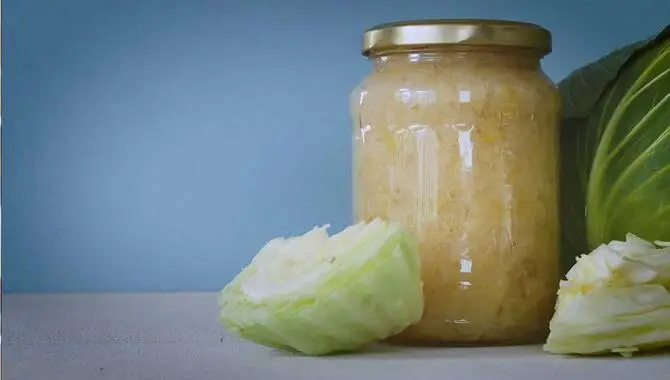
There are several methods for making traditional sauerkraut, each with its benefits and flavor profiles. People use the “dry salt” method to ferment cabbage in its juices by mixing it with salt. This method produces a tangy and crunchy sauerkraut perfect for adding to sandwiches or serving as a side dish.
Another method is the “brine” method, where cabbage is submerged in a saltwater solution. This method results in milder and slightly sweeter sauerkraut that is great for incorporating into recipes like soups or stews.
Whichever method you choose, the key to successful sauerkraut fermentation is using fresh cabbage and ensuring the fermentation vessel is clean and properly sealed. With a little patience, you can enjoy homemade sauerkraut packed with probiotics and delicious flavor.
Slicing, Pounding, And Kneading Cabbage
To prepare homemade sauerkraut, begin by slicing your cabbage into thin strips. This technique helps achieve a desirable texture and promotes the fermentation process. Next, release the cabbage’s juices by using a wooden or plastic tool to pound it.
This step is crucial as it creates a brine essential for successful fermentation. Lastly, knead the cabbage with salt to break down its cell walls and help kickstart the fermentation process. By incorporating these steps, you can master fermenting traditional sauerkraut, a beloved side dish with numerous health benefits.
Weighting And Pressing Sauerkraut In A Crock
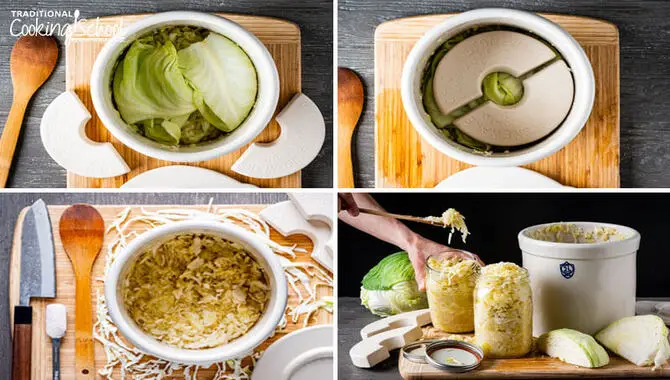
When it comes to fermenting sauerkraut, the right environment is key. One method that achieves this is weighting and pressing sauerkraut in a crock. This process ensures that every bit of cabbage is submerged in its own brine, creating the perfect anaerobic conditions for fermentation.
To start, shred your cabbage and add salt, then place it in a clean and sanitized crock. Next, use a weight to press the shredded cabbage down, extracting its liquid. This weight should be heavy enough to submerge the cabbage throughout fermentation, safeguarding it from contamination. Properly weighing and pressing your sauerkraut in a crock is crucial for successful fermentation.
Whole Cabbage Heads With Brine
To ferment traditional sauerkraut, you can try a method that involves using whole cabbage heads with brine. Begin by separating the outer leaves of the cabbage heads and keeping them aside. Cut the cabbage into quarters and remove the core.
Next, shred or thinly slice the cabbage and transfer it to a spacious bowl. Sprinkle approximately 1-2 tablespoons of salt per head of cabbage over the shredded cabbage. Gently massage the salt into the cabbage, allowing it to release its natural liquid.
Conclusion
Fermenting traditional sauerkraut is a simple and rewarding process that allows you to enjoy the tangy and probiotic-rich goodness of homemade sauerkraut. You can ensure successful fermentation by using fresh cabbage, the right salt and creating an anaerobic environment.
Whether you choose the slicing and pounding method, weighting and pressing in a crock, or whole cabbage heads with brine, the key is to give your sauerkraut enough time to ferment and develop its flavors. By following the steps on how to ferment traditional sauerkraut recipe, you can create your own batch of sauerkraut at home and enjoy the tangy flavors and health benefits that come with it.
Remember to use fresh cabbage, quality salt, and proper fermentation containers to ensure the best results. Experiment with different flavor additions, such as caraway seeds or juniper berries, to customize your sauerkraut to your liking.
Frequently Asked Questions
How Long Should You Ferment Sauerkraut?
For optimal flavor and texture, sauerkraut should be fermented for at least one to two weeks. However, the fermentation time can be adjusted based on personal preference. To determine if it has reached the desired level of sourness, taste the sauerkraut after a week. Remember to store it in a cool and dark place while it ferments.
What Is Sauerkraut, And Why Is It Good For You?
Sauerkraut is a traditional German dish made by fermenting cabbage with salt. This process creates a tangy flavor and preserves the vegetables. Sauerkraut is packed with probiotics that promote gut health, vitamins C and K, and fiber, making it a nutritious choice for your diet.
What Are The Benefits Of Fermenting Foods?
Fermenting foods not only preserves their nutrients and improves digestibility but also boosts gut health with beneficial probiotics. Additionally, fermentation enhances the taste and texture of foods while supporting a strong immune system.
How Can I Make My Own Fermented Foods At Home?
To make fermented foods at home, research and select a recipe. Collect the required ingredients and equipment, like glass jars and fermentation weights. Follow the recipe closely, maintaining good hygiene. Let the food ferment at the recommended temperature and time, tasting occasionally to achieve the desired flavor.
Can I Add Flavors Or Ingredients To My Sauerkraut During Fermentation?
Absolutely, you have the freedom to add extra flavors or ingredients to your sauerkraut while it ferments. Some popular choices include caraway seeds, juniper berries, garlic, and chili flakes. Feel free to get creative and try different combinations for unique sauerkraut variations. Remember that you may need to adjust the fermentation time based on the added ingredients.

I’m a writer and blogger who loves to talk about entertainment, culture, and relationships. I love to share my thoughts and insights on these topics, and I’m always looking for new ways to engage with my readers. I’m also a big fan of learning new things, so I’m always exploring new areas of interest.
